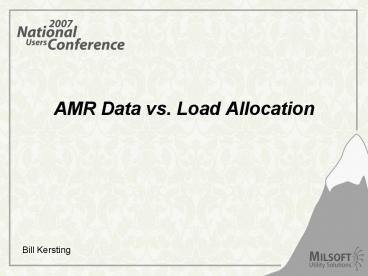AMR Data vs. Load Allocation PowerPoint PPT Presentation
1 / 47
Title: AMR Data vs. Load Allocation
1
AMR Data vs. Load Allocation
Bill Kersting
2
What is the purpose of an electric utility?
- Make money?
- Break even?
- Public Service Charity?
3
ANSI Voltage Standards
- Range A Normal Steady-State
- Nominal Utilization Voltage 115 volts
- Maximum Utilization Voltage 126 volts
- Minimum Service Voltage 114 volts
- Minimum Utilization Voltage 110 volts
- Range B Emergency Steady-State
- Nominal Utilization Voltage 115 volts
- Maximum Utilization Voltage 127 volts
- Minimum Service Voltage 110 volts
- Minimum Utilization Voltage 107 volts
4
Voltage Drop
5
- Impedance (Z) and current (I) must be computed as
accurately as possible - Impedance best computed using Carsons Equations
- Current is a function of load
- If Z and I are not computed accurately, all bets
are off on the calculated system voltages
6
Voltage Profile
7
What is this thing called Load?
8
Transformer Loading
9
Customer 1
10
Customer 2
11
Customer 3
12
Customer 4
13
Transformer Diversified Demand
14
Summary
15
AMR Data
- May, June and July 2006 data recorded
- 314 customers
- 15 minute kW demand per customer
- 23 transformers
- 15 minute diversified kW demand computed
- Studies will involved using the 15 minute
diversified kW demand as the load for each
transformer - 90 power factor will be assumed
16
Transformer kVA Rating and of Customers
17
Peak Day
- July 17, 1006
- Time of max 15 min kW demand 1745
18
Transformer Loading 7/17/2006
19
Sum of Transformer Demands
20
7/17/2006 Transformer Data
21
Load and Utilization Factors
22
Time of max 15 minute Demands
23
What to do with all of this Data?
- Model using the IEEE 34 node test feeder
- http//ewh.ieee.org/soc/pes/dsacom/testfeeders.ht
ml - Base case will model each transformer with its 15
minute demand at the time of the total peak
(1745, July 17, 2006) - Computed kW and kVAr at the substation will be
the same as if metered
24
IEEE 34 Node Test Feeder
25
IEEE 34 Node Test Feeder
- Nominal voltage 24.9 kV (line-to-line)
- Very long (35 miles) and lightly loaded
- Two in-line step voltage regulators
- One in-line transformer reducing voltage for a
short 4.16 kV feeder - Shunt capacitors
- Spot and distributed loads
26
IEEE 34 Node Feeder Modifications
- Disconnect voltage regulators
- Disconnect shunt capacitors
- Represent each of the 23 transformers as a spot
constant wye connected PQ load
27
Windmil 34 Node Test Feeder Model
28
Base Case kW Demands 90 Power Factor Assumed
29
Windmil IEEE 34 Node Feeder
- Base Case Results
- Sa 382.28 j 130.96 kVA
- Sb 377.16 j 127.73 kVA
- Sc 525.79 j 229.27 kVA
- Stotal 1,285.27 j 487.97 kVA
- Sloss 86 j 62 kVA
- Qcharging -j 154 kVAr
30
Base Case Node Voltages
31
Allocation Methods to Study
- The source control point will be set to hold the
phase complex powers constant for the following
allocation method - Daily kWH
- Monthly kWH
- Transformer kVA
- REA
32
July 17, 2006 kWH
33
July 2006 kWH
34
Allocated Loads by Method
35
Percent kW Demand Error
36
Transformer T-01Percent kW Demand Error
37
Transformer T-17Percent kW Demand Error
38
Average kW Demand Percent Error
39
Node Voltages (120 V base)
40
Percent Node Voltage Errors
41
Average Percent Node Voltage Error
42
Major Conclusion to this Point
- Monthy kWH gives the closes load modeling to the
Base Case - What about lateral control points?
- Data from base case
- Line 824-T04 155 kW j 65 kVAr
- Line 834 T-15
- Phase B 78 kW j 37 kVAr
- Phase C 83 j 39 kVAr
43
Monthly kWH with and without control points
44
Percent kW Demand Error with and without Ctr.
Pts.Compared to Base Case
45
Node Voltage Profile with Ctr. Pts.
46
Percent Voltage Error with Ctr. Pts.Compared to
Base Case
47
Final Conclusions
- AMR 15-minute kW demand readings give a wealth of
information about the loading of a distribution
feeder - The modeling of loads is critical to the accuracy
of the study - With the four methods of allocation the
allocation based upon monthly kWH gives the
smallest error - Use of control nodes makes the study even more
accurate

